 Last additions Last additions |

Dec 17, 2005
|
|

Dec 17, 2005
|
|

Dec 17, 2005
|
|

Dec 17, 2005
|
|

Dec 17, 2005
|
|

Numerous azalea bushesDec 17, 2005
|
|

Dec 17, 2005
|
|
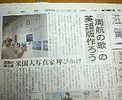
In the news: Article in Asahi Shimbun, Dec. 11, 2005 Sunday morning edition. The headline reads, "Let's Make an English Version of the Rowing Song."A reporter for the Asahi Shimbun in Otsu thought my project was worthy enough for a story in the Dec. 11, 2005 Sunday morning edition of the newspaper's Shiga News page (distributed in Shiga Prefecture).
The headline reads, "Let's Make an English Version of the Boat Song." It describes my project to create an English version of the song and have it sung at the annual choir contest in June in Imazu (which didn't happen in 2006). It also quotes people in Imazu who welcome my project for an English version.
2005年12月11日の朝日新聞朝刊の滋賀版に僕の写真展と歌の英語化を大きく掲載されました。あんなちっぽけな写真展で注目されるなんて想像もつきませんでした。
英語版を2006年6月3日に発表したあとも各新聞紙の滋賀版で大きく報道されました。詳細はここ。Dec 12, 2005
|
|

Water fountain in front of Ritto StationDec 09, 2005
|
|

Recycling truckDec 09, 2005
|
|

Recycling truckDec 09, 2005
|
|

Symbol of Ritto and Ritto StationDec 09, 2005
|
|

Inside Ritto Station and sign celebrating the decision to build a shinkansen station in Ritto. Celebration has been muted after the new governor was elected in July 2006.Dec 09, 2005
|
|

Ritto Station. MAPDec 09, 2005
|
|

Site of the proposed shinkansen station in Ritto. Not exacttly convenient.Dec 09, 2005
|
|

Sumo ring within shrine groundsDec 09, 2005
|
|

Dec 09, 2005
|
|

Path back to Ritto StationDec 09, 2005
|
|

Dec 09, 2005
|
|

Dec 09, 2005
|
|

Dec 09, 2005
|
|

Dec 09, 2005
|
|

Dec 09, 2005
|
|
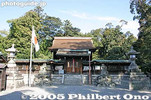
Dec 09, 2005
|
|

Main shrineDec 09, 2005
|
|

Main shrineDec 09, 2005
|
|

Dec 09, 2005
|
|

Dec 09, 2005
|
|

Dec 09, 2005
|
|

GateDec 09, 2005
|
|

Dec 09, 2005
|
|

Path to shrineDec 09, 2005
|
|

Side toriiDec 09, 2005
|
|

Dedicated to Susano-O no Mikoto, Daiho Shrine is a short walk from JR Ritto Station. Main torii. MAPDec 09, 2005
|
|

Kusatsu-juku Kaido Koryu-kan草津街道交流館Dec 09, 2005
|
|

Ukiyoe prints of Kusatsu-juku at Kusatsu-juku Kaido Koryu-kan 草津街道交流館Dec 09, 2005
|
|

Kusatsu-juku Kaido Koryu-kan. Sample food from the old days, dinner on left and breakfast on right. 草津街道交流館Dec 09, 2005
|
|

Waki Honjin souvenir shop and restaurant脇本陣Dec 09, 2005
|
|

Model of the town at the Kusatsu-juku Kaido Koryu-kan 草津街道交流館Dec 09, 2005
|
|

Honjin owner's houseDec 09, 2005
|
|

Palanquin at Kusatsu-juku Kaido Koryu-kan 草津街道交流館For photos.Dec 09, 2005
|
|

Kusatsu-juku Kaido Koryu-kan 草津街道交流館Dec 09, 2005
|
|

Bath for feudal lordsLooks kind of small to me.
湯殿Dec 09, 2005
|
|

Kusatsu-juku Kaido Koryu-kan is a history museum with various exhibits showing Kusatsu's post town history. Admission 200 yen. You can buy a set ticket good for both the Honjin and this history museum. 草津街道交流館Dec 09, 2005
|
|

Photo op room at Kusatsu-juku Kaido Koryu-kan. You can dress up as a traveler on the Tokaido/Nakasendo Road and take a picture of yourself. You can even sit in the palanquin. A tripod is provided too. 草津街道交流館Dec 09, 2005
|
|

Kusatsu-juku Kaido Koryu-kan. Terminals are provided to find information about Kusatsu. 草津街道交流館 MAPDec 09, 2005
|
|

CeilingDec 09, 2005
|
|

Marker for Emperor Meiji's visit and outdoor gardenDec 09, 2005
|
|

Kitchen (Daidokoro doma). Dirt-floored room with wood-heated stoves. High ceiling with no chimney, but the ceiling has a covered opening. 台所土間
Dec 09, 2005
|
|

Honjin owner Tanaka's houseDec 09, 2005
|
|

Honjin owner Tanaka's houseDec 09, 2005
|
|

Mukae Jodan no Ma 向上段の間向上段の間Dec 09, 2005
|
|

Dec 09, 2005
|
|

Yudono bath room for warlords. The hot water was heated nearby and carried to this room. 湯殿
Dec 09, 2005
|
|

Outdoor gardenDec 09, 2005
|
|

Toilet (made of lacquered wood) for warlords. This is a separate room adjacent to the urinal. It also has two tatami mats. The walls are plain and not decorated. The toilet had a box which was likely replaced each time it was used. 上段雪隠This is a separate room adjacent to the urinal. It also has two tatami mats. The walls are plain and not decorated. The toilet had a box which was likely replaced each time it was used.
Jodan settin
上段雪隠Dec 09, 2005
|
|

Urinal (made of lacquered wood) for warlords. The room has two tatami mats. Right below the urinal is a bamboo mat. Above is a small shoji paper window to provide light.Dec 09, 2005
|
|

Mukae Jodan no Ma. Painting on the fusuma sliding doors by Matsumura Keibun. 向上段の間Dec 09, 2005
|
|

Jodan no Ma: Kusatsu-juku Honjin's best room in the house. Reserved for daimyo warlords, emperors, etc. 上段の間
Dec 09, 2005
|
|

Jodan no Ma - Kusatsu-juku Honjin. The Gyokuza raised tatami mats was where the lord or Emperor slept or sat. 上段の間Reserved for daimyo warlords, emperors, etc. Dec 09, 2005
|
|

Jodan no Ma - Kusatsu-juku Honjin's best room in the house. Reserved for daimyo warlords, emperors, etc. 上段の間Dec 09, 2005
|
|

Jodan no Ma - Kusatsu-juku Honjin's best room in the houseReserved for daimyo warlords, emperors, etc. The room had an elevated tatami mat for the person to sit and sleep on.
上段の間Dec 09, 2005
|
|

Sekifuda name plates in Genkan Hiroma entrance hall. This is what you see when you enter the Honjin through the Genkan Hiroma entrance hall. The name plate for the warlord staying at the lodge was displayed. 玄関広間This is what you see when you enter the Honjin through the Genkan Hiroma entrance hall. The name plate for the warlord staying at the lodge was displayed here.Dec 09, 2005
|
|

Kusatsu-juku Honjin guest book. See the names of Kira and Lord Asano both of whom once lodged at this Honjin (at different times). These two men later became adversaries which led to the legendary chushingura or vendetta of the 47 masterless samurai. 大�You can see the names of Kira and Lord Asano both of whom once lodged at this Honjin (at different times). These two men later became adversaries which led to the legendary chushingura or vendetta of the 47 masterless samurai.
大福帳Dec 09, 2005
|
|

Kusatsu-juku Honjin corridor. Pass by numerous Japanese-style rooms. 畳廊下畳廊下Dec 09, 2005
|
|
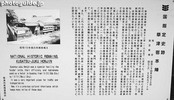
About the Kusatsu-juku HonjinDec 09, 2005
|
|

Kusatsu-juku Honjin. the Honjin was the town's most luxurious accommodation catering to society's elite like daimyo warlords, Imperial family members including the emperor, and other dignitaries. National Historic SiteAt stage towns along the major roads like the Nakasendo and Tokaido, the Honjin was the town's most luxurious accommodation catering to society's elite like daimyo warlords, Imperial family members including the emperor, and other dignitaries. It operated during 1635 to 1870. The Honjin is now a museum.
This Honjin in Kusatsu is a very impressive example of traditional architecture. It is designated as a National Historical Place. It underwent a complete renovation and reconstruction during 1989 to 1995. (In case you wonder why such an old building looks so new.) Admission 200 yen. 10-min. walk from Kusatsu Station.Dec 09, 2005
|
|

Genkan Hiroma entrance hall straight ahead. It was the entrance for daimyo feudal lords. 玄関広間Dec 09, 2005
|
|

Kusatsu-juku Honjin entrance. This Honjin in Kusatsu is a very impressive example of traditional architecture. It is designated as a National Historical Place. It underwent a complete renovation and reconstruction during 1989 to 1995. Admission 200 yen.Dec 09, 2005
|
|

Kusatsu-juku Honjin on the Tokaido Road. MAPDec 09, 2005
|
|

Road marker at the intersection of the Tokaido and Nakasendo RoadsThis tunnel goes under the Kusatsu River.Dec 09, 2005
|
|

Kusatsu historyBeing a stage town along the Tokaido Road connecting Edo (Tokyo) and Kyoto, Kusatsu had over 70 inns for travelers. The best inn was the Honjin, reserved for daimyo warlords, Imperial family members, etc.Dec 09, 2005
|
|
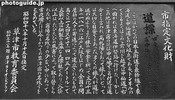
Road marker plaqueDec 09, 2005
|
|

Oiwake Guidepost road marker at the intersection of the Tokaido and Nakasendo Roads. The left side says "Left for Nakasendo Road" and the right side says "Right for Tokaido Road."Dec 09, 2005
|
|

JR Kusatsu StationDec 09, 2005
|
|

Kusatsu RiverDec 09, 2005
|
|

Kusatsu town map. Kusatsu basically developed along the old Nakasendo and Tokaido Roads as they intersected before going on to Kyoto, Shiga's neighboring prefecture.Dec 09, 2005
|
|

Kusatsu-juku was the fifty-second station on the Tokaido Road (following Ishibe-juku) and the sixty-eighth station (following Moriyama-juku) on the Nakasendo Road. During the Edo Period, Kusatsu was an important post town at the crossroads of both roads.The roof is shaped like a Honjin lodge, with a gate. 草津駅Dec 09, 2005
|
|

Sansho ShrineDec 08, 2005
|
|

Sansho Shrine 三聖神社The shrine is right next to the temple.Dec 08, 2005
|
|

Temple bellDec 08, 2005
|
|

Sansho ShrineDec 08, 2005
|
|

Kannon stone buddhaDec 08, 2005
|
|

Fall colorsDec 08, 2005
|
|

Dec 08, 2005
|
|

Dec 08, 2005
|
|

Dec 08, 2005
|
|

Kannon stone buddhaThe temple grounds has 33 stone buddhas.Dec 08, 2005
|
|

Dec 08, 2005
|
|

Dec 08, 2005
|
|

Dec 08, 2005
|
|

Dec 08, 2005
|
|

Dec 08, 2005
|
|

Jorakuji's Three-story pagoda is also a National Treasure Built in 1400.Dec 08, 2005
|
|

Dec 08, 2005
|
|

Dec 08, 2005
|
|

Dec 08, 2005
|
|

3-story pagoda, also a National TreasureDec 08, 2005
|
|

Built in 1400We cannot enter it.Dec 08, 2005
|
|

Dec 08, 2005
|
|

Dec 08, 2005
|
|

HondoDec 08, 2005
|
|

Entrance to temple hallInside are statues of gods and Buddhas designated as Important Cultural Properties. One of them was stolen, so there are security cameras inside the temple. Photography is also forbidden.Dec 08, 2005
|
|

Temple roof of Jorakuji temple.Dec 08, 2005
|
|

Hondo temple hallDec 08, 2005
|
|

Hondo temple hallDec 08, 2005
|
|

Jorakuji Hondo hall, a National Treasure in Konan, Shiga. The pagoda on the left is also a National Treasure. The original temple burned down in 1360, and rebuilt the same year.Dec 08, 2005
|
|

Pagoda and Hondo temple hallDec 08, 2005
|
|
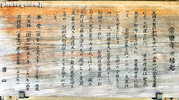
About the templeThe temple was established in 708 as ordered by the emperor.Dec 08, 2005
|
|

EntranceDec 08, 2005
|
|

Gate guardian (right side)In the San-mon GateDec 08, 2005
|
|

Path to templeDec 08, 2005
|
|

Gate guardian (left side)In the San-mon GateDec 08, 2005
|
|

San-mon Gate 山門 MAPDec 08, 2005
|
|

In the deep-green forest, you can see part of the pagoda's roof. You can walk to Jorakuji (means "Constant Comfort Temple") from Chojuji Temple. From Ishibe Station, best to take a bus to Chojuji first, then walk downhill to Jorakuji. EntraDec 08, 2005
|
|

A stone's throw from Chojuji Temple, Jorakuji Temple (est. 708) of the Tendai Buddhist Sect boasts two National Treasures with its main hall and three-story pagoda. It is one of the Konan Sanzan Temple Trio accessible by bus from JR Ishibe Station.In the deep-green forest, you can see part of the pagoda's roof.Dec 08, 2005
|
|

ShrineDec 08, 2005
|
|

ShrineDec 08, 2005
|
|

Dec 08, 2005
|
|

ShrineDec 08, 2005
|
|

Shrine pathDec 08, 2005
|
|

Dec 08, 2005
|
|

Shrine next to templeDec 08, 2005
|
|
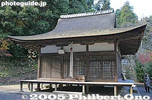
ShrineDec 08, 2005
|
|

Dec 08, 2005
|
|

Pagoda foundationThere used to be a 3-story pagoda, but Oda Nobunaga moved it to his temple. The stone foundations still remain.Dec 08, 2005
|
|

Benten-doDec 08, 2005
|
|

Dec 08, 2005
|
|

Dec 08, 2005
|
|

Benten-doDec 08, 2005
|
|

Benten-doDec 08, 2005
|
|

Dec 08, 2005
|
|

Information signDec 08, 2005
|
|

Benten-doDec 08, 2005
|
|

Dec 08, 2005
|
|

Chojuji temple Hondo temple hall, National TreasureDec 08, 2005
|
|

Hondo temple hallDec 08, 2005
|
|

Chojuji temple Hondo temple hall, National Treasure in Konan, Shiga.The hondo once burned down, but was rebuilt during the Kamakura Period.Dec 08, 2005
|
|

Hondo temple hall, National TreasureDec 08, 2005
|
|

Fall colors are also nice. Accessible by bus from Ishibe Station or walk from Jorakuji. Path to temple. MAPDec 08, 2005
|
|

Dec 08, 2005
|
|

Meaning "Long Life Temple," Chojuji's Hondo temple hall is a National Treasure. It belongs to the Tendai Buddhist Sect and one of the Konan Sanzan Temple Trio along with Jorakuji and Zensuiji Temples.Chojuji temple Entrance gate + fall colors.Dec 08, 2005
|
|

Church houseDec 08, 2005
|
|

Tokaido History Museum includes an accurate model of Ishibe-juku's palatial Kojima Honjin.Dec 08, 2005
|
|

Dec 08, 2005
|
|

Dec 08, 2005
|
|

Ishibe High School. Rare to see a Japanese high school whose name is shown in English.Dec 08, 2005
|
|

Church houseDec 08, 2005
|
|

Ishibe Town logoDec 08, 2005
|
|

Tea houseDec 08, 2005
|
|

Tokaido History Museum is adjacent to Shukuba no Sato. It explains the 53 stage towns of the Tokaido Road between Edo and Kyoto. 東海道歴史資料館Dec 08, 2005
|
|

Dec 08, 2005
|
|

Old fire truckDec 08, 2005
|
|

Tea houseDec 08, 2005
|
|

Rice warehouseDec 08, 2005
|
|

Inn kitchenDec 08, 2005
|
|

Rice warehouseDec 08, 2005
|
|

Dec 08, 2005
|
|

Guest name plates in the innDec 08, 2005
|
|

Merchant's houseDec 08, 2005
|
|

Inn (hatago) 旅籠Dec 08, 2005
|
|

InnDec 08, 2005
|
|

Old farming implements (for irrigation)Dec 08, 2005
|
|
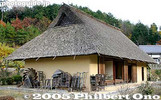
Farmer's houseDec 08, 2005
|
|

Traditional farmer's houseDec 08, 2005
|
|

Merchant's house 商家Dec 08, 2005
|
|

Traditional farmer's houseDec 08, 2005
|
|

Gate 関所Dec 08, 2005
|
|

Traditional farmer's houseDec 08, 2005
|
|

Traditional farmer's house 農家Dec 08, 2005
|
|

Dec 08, 2005
|
|

Entrance to Shukuba no Sato, outdoor museum of stage town buildings 宿場の里 MAPDec 08, 2005
|
|

About Shukuba no Sato. Interesting outdoor museum of Edo-Period buildings accurately reconstructed as was found in Ishibe-juku. You can find a farmer's house, merchant's house, inn, tea house, and warehouse. The inside is also quite authentic.Dec 08, 2005
|
|

Entrance to Ameyama Cultural Sports Park, a low hill with various sports and cultural facilities and hiking trails.Dec 08, 2005
|
|

Ishibe was usually the first overnight stop for travelers going from Kyoto to Edo (Tokyo). The Honjin is no longer in existence, and only a normal house sits on the site.Dec 08, 2005
|
|

Site of Kojima Honjin and Emperor Meiji marker. The Kojima Honjin was Ishibe-juku's best accommodation suited for feudal lords and emperors.Dec 08, 2005
|
|

Woodblock print of Ishibe-jukuDec 08, 2005
|
|

Dec 08, 2005
|
|

Inside reconstructed tea houseDec 08, 2005
|
|

Gate in front of Ishibe StationDec 08, 2005
|
|

Dengaku Chaya tea house reconstructed in 2003 based on Hiroshige's ukiyoe print of Ishibe. A rest place for tourists. Walkable from Ishibe Station. 田楽茶屋The original tea house as seen in Hiroshige's print was located some distance away (nearer to Ritto) from the location of this reconstructed tea house. Dec 08, 2005
|
|

In front of JR Ishibe Station. There are many bicycle garages for out-of-town students who commute from the station to their high school in Ishibe.Dec 08, 2005
|
|

Ishibe-juku was the 51st stage/post or shukuba lodging town on the Tokaido Road where even Emperor Meiji once stayed (with an entourage of over 3,000). View from JR Ishibe Station. Ishibe in Konan city is rural, yet it has a few major industries operating.Dec 08, 2005
|
|

JR Ishibe Station before renovations.Dec 08, 2005
|
|

JR Ishibe StationDec 08, 2005
|
|

Bicycle rental station next to Omi-Hachiman Station. You can rent a bicycle until 11 pm so you can stay in town late to see night festivals.Best way to tour the city.Dec 08, 2005
|
|
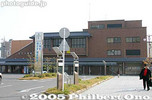
Omi-Hachiman StationDec 08, 2005
|
|

Gift shopDec 08, 2005
|
|

Dec 08, 2005
|
|
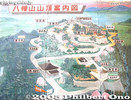
Hachiman-yama mapDec 08, 2005
|
|

Dec 08, 2005
|
|

Dec 08, 2005
|
|

Dec 08, 2005
|
|

Dec 08, 2005
|
|

Dec 08, 2005
|
|

Castle wall and fall colorsDec 08, 2005
|
|

Inari-do Shrine 稲荷堂Dec 08, 2005
|
|

Dec 08, 2005
|
|

View of Omi-Hachiman city center from Mt. Hachiman-yama.Dec 08, 2005
|
|

Lookout in front of templeDec 08, 2005
|
|

Inside templeDec 08, 2005
|
|

Lookout in front of templeDec 08, 2005
|
|

View from temple groundsDec 08, 2005
|
|

Zuiryuji Temple of Nichiren Sect in the Honmaru 村雲御所瑞龍寺Dec 08, 2005
|
|

Castle wallDec 08, 2005
|
|

Hachiman-yama Castle wallDec 08, 2005
|
|

Site of Hachiman-yama Castle in Omi-Hachiman.Dec 08, 2005
|
|

San-mon Gate 山門Dec 08, 2005
|
|

Steps to templeDec 08, 2005
|
|

Dec 08, 2005
|
|

Dec 08, 2005
|
|

Nishi-no-ko Lake as seen from Kitanomaru atop Mt. Hachiman-yama.Dec 08, 2005
|
|

View from KitanomaruDec 08, 2005
|
|

View from KitanomaruDec 08, 2005
|
|

View from KitanomaruDec 08, 2005
|
|

View from KitanomaruDec 08, 2005
|
|

Kitanomaru 北の丸跡Dec 08, 2005
|
|

View of Lake Biwa from Nishinomaru on Mt. Hachimanyama in Omi-Hachiman.Dec 08, 2005
|
|

NishinomaruDec 08, 2005
|
|

NishinomaruDec 08, 2005
|
|

View from Nishinomaru 西の丸跡Dec 08, 2005
|
|

View from NishinomaruDec 08, 2005
|
|

View from NishinomaruDec 08, 2005
|
|

Dec 08, 2005
|
|

Dec 08, 2005
|
|

Onegai Jizo-do Hall おねがい地蔵堂Dec 08, 2005
|
|

Dec 08, 2005
|
|

Dec 08, 2005
|
|

Dec 08, 2005
|
|

Dec 08, 2005
|
|

Hachiman-yama mapDec 08, 2005
|
|

Dec 08, 2005
|
|

Hachiman-yama ropeway takes only 4 min. to go upDec 08, 2005
|
|

Hachiman-yama ropeway stationA short walk from Hachiman-bori canal.Dec 08, 2005
|
|

At 271 meters high, Mt.Hachiman-yama was the site of Hachiman Castle built by Toyotomi Hidetsugu in 1585. Now home to Zuiryuji temple of the Nichiren Sect, some of the castle's stone walls still remain. MAPDec 08, 2005
|
|

Chomeiji pierDec 08, 2005
|
|

Lake Biwa Rowing Song (Biwako Shuko no Uta) monument for Verse 6 琵琶湖就航の歌 歌碑Dec 08, 2005
|
|

Lake Biwa Rowing Song (Biwako Shuko no Uta) monument 琵琶湖就航の歌 歌碑Dec 08, 2005
|
|
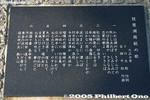
Lake Biwa Rowing Song (Biwako Shuko no Uta) monument 琵琶湖就航の歌 歌碑Dec 08, 2005
|
|

天尊堂Dec 08, 2005
|
|

Dec 08, 2005
|
|

Stairs back downDec 08, 2005
|
|

Dec 08, 2005
|
|

大権現社Dec 08, 2005
|
|

Giant rockDec 08, 2005
|
|

As seen from the bell towerDec 08, 2005
|
|

Chomeiji bus stopDec 08, 2005
|
|

Dec 08, 2005
|
|

Lake Biwa Rowing Song (Biwako Shuko no Uta) monument 琵琶湖就航の歌 歌碑The song is about a four-day, boat-rowing trip around Lake Biwa undertaken on June 27, 1917 by seven college students. They were in the rowing club at an elite college in Kyoto called Dai-san Koto Gakko (No. 3 High School 第三高等学校) which later merged with Kyoto University. They started at Otsu and rowed to Omatsu (now called Omi-Maiko), Imazu, Chikubushima island, Nagahama, Hikone, Chomeiji, and back to Otsu. They stopped overnight at Omatsu, Imazu, and Hikone.
For a detailed explanation of this song and monument, this album.
Biwako Shuko no UtaDec 08, 2005
|
|

Dec 08, 2005
|
|

Dec 08, 2005
|
|

Dec 08, 2005
|
|
| 71466 files on 284 page(s) |
 |
 |
274 |  |
 |
|